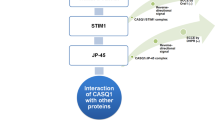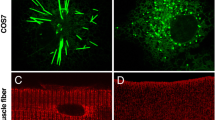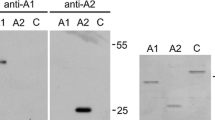Abstract
Calsequestrin (Casq) is a high capacity, low affinity Ca2+-binding protein, critical for Ca2+-buffering in cardiac and skeletal muscle sarcoplasmic reticulum. All vertebrates have multiple genes encoding for different Casq isoforms. Increasing interest has been focused on mammalian and human Casq genes since mutations of both cardiac (Casq2) and skeletal muscle (Casq1) isoforms cause different, and sometime severe, human pathologies. Danio rerio (zebrafish) is a powerful model for studying function and mutations of human proteins. In this work, expression, biochemical properties cellular and sub-cellular localization of D. rerio native Casq isoforms are investigated. By quantitative PCR, three mRNAs were detected in skeletal muscle and heart with different abundances. Three zebrafish Casqs: Casq1a, Casq1b and Casq2 were identified by mass spectrometry (Data are available via ProteomeXchange with identifier PXD002455). Skeletal and cardiac zebrafish calsequestrins share properties with mammalian Casq1 and Casq2. Skeletal Casqs were found primarily, but not exclusively, at the sarcomere Z-line level where terminal cisternae of sarcoplasmic reticulum are located.





Similar content being viewed by others
Abbreviations
- B2M:
-
Beta-2 microglobulin
- casq :
-
Zebrafish calsequestrin genes
- Casq:
-
Zebrafish calsequestrin proteins
- DTT:
-
DL-Dithiothreitol
- EF1a:
-
Elongation factor 1-alpha
- NDUFS3:
-
NADH dehydrogenase [ubiquinone] iron-sulfur protein 3
- EGTA:
-
Ethylene glycol-bis(2-aminoethylether)-N,N,N′,N′-tetraacetic acid
- HEPES:
-
4-(2-Hydroxyethyl)piperazine-1-ethanesulfonic acid
- MOPS:
-
4-Morpholinepropanesulfonic acid
- PMSF:
-
Phenylmethylsulfonyl fluoride
- Ryr:
-
Ryanodine receptor
- SDS:
-
Sodium dodecyl sulfate
- SERCA1:
-
Sarcoplasmic/endoplasmic reticulum calcium ATPase 1
- SR:
-
Sarcoplasmic reticulum
References
Asnani A, Peterson RT (2014) The zebrafish as a tool to identify novel therapies for human cardiovascular disease. Dis Model Mech 7:763–767
Babin PJ, Goizet C, Raldúa D (2014) Zebrafish models of human motor neuron diseases: advantages and limitations. Prog Neurobiol 118:36–58
Bal NC, Jena N, Chakravarty H, Kumar A, Chi M, Balaraju T, Rawale SV, Rawale JS, Sharon A, Periasamy M (2015) The C-terminal calcium-sensitive disordered motifs regulate isoform-specific polymerization characteristics of calsequestrin. Biopolymers 103:15–22. doi:10.1002/bip.22534
Berger J, Currie PD (2012) Zebrafish models flex their muscles to shed light on muscular dystrophies. Dis Model Mech 5:726–732. doi:10.1242/dmm.010082
Braasch I, Postlethwait JH (2012) Fish polyploidy and the teleost genome duplication. In: Soltis PS, Soltis DE (eds) Polyploidy and genome evolution. Springer, Berlin, pp 341–383
Bradford MM (1976) A rapid and sensitive method for the quantitation of microgram quantities of protein utilizing the principle of protein-dye binding. Anal Biochem 72:248–254
Burgess WH, Jemiolo DK, Kretsinger RH (1980) Interaction of calcium and calmodulin in the presence of sodium dodecyl sulfate. Biochim Biophys Acta 623:257–270
Cala SE, Jones LR (1983) Rapid purification of calsequestrin from cardiac and skeletal muscle sarcoplasmic reticulum vesicles by Ca2+-dependent elution from phenyl-sepharose. J Biol Chem 258:11932–11936
Campbell KP, MacLennan DH, Jorgensen AO (1983) Staining of the Ca2+-binding proteins, calsequestrin, calmodulin, troponin C, and S-100, with the cationic carbocyanine dye “Stains all”. J Biol Chem 258:11267–11273
Caprara GA, Perni S, Morabito C, Mariggiò MA, Guarnieri S (2014) Specific association of growth-associated protein 43 with calcium release units in skeletal muscles of lower vertebrates. Eur J Histochem 58(4):296–300
Cox JA, Stein EA (1981) Characterization of a new sarcoplasmic calcium-binding protein with magnesium-induced cooperativity in the binding of calcium. Biochemistry 20:5430–5436
Damiani E, Margreth A (1991) Subcellular fractionation to junctional sarcoplasmic reticulum and biochemical characterization of 170 kDa Ca2+- and low-density-lipoprotein-binding protein in rabbit skeletal muscle. Biochem J 277:825–832
Damiani E, Salvatori S, Zorzato F, Margreth A (1986) Characteristics of skeletal muscle calsequestrin: comparison of mammalian, amphibian and avian muscles. J Muscle Res Cell Motil 7:435–445
Devoto SH, Melançon E, Eisen JS, Westerfield M (1996) Identification of separate slow and fast muscle precursor cells in vivo, prior to somite formation. Development 122:3371–3380
Franzini-Armstrong C, Eastwood AB, Peachey LD (1986) Shape and disposition of clefts, tubules, and sarcoplasmic reticulum in long and short sarcomere fibers of crab and crayfish. Cell Tissue Res 244:9–19
Green MR, Pastewka JV, Peacock AC (1973) Differential staining of phosphoproteins on polyacrylamide gels with a cationic carbocyanine dye. Anal Biochem 56(1):43–51
Hayashi K, Miller RG, Brownell KW (1987) Three-dimensional architecture of sarcoplasmic reticulum and T-system in human skeletal muscle. Anat Rec 218:275–283
Infante C, Ponce M, Manchado M (2011) Duplication of calsequestrin genes in teleosts: molecular characterization in the Senegalese sole (Solea senegalensis). Comp Biochem Physiol B 158:304–314. doi:10.1016/j.cbpb.2011.01.002
Klitgaard H, Ausoni S, Damiani E (1989) Sarcoplasmic reticulum of human skeletal muscle: age-related changes and effect of training. Acta Physiol Scand 591:6053–6068. doi:10.1113/jphysiol.2013.265900
Kumar A, Chakravarty H, Bal NC, Balaraju T, Jena N, Misra G, Bal C, Pieroni E, Periasamy M, Sharon A (2013) Identification of calcium binding sites on calsequestrin 1 and their implications for polymerization. Mol BioSyst 9:1949–1957. doi:10.1039/c3mb25588c
Laemmli UK (1970) Cleavage of structural proteins during the assembly of the head of bacteriophage T4. Nature 227:680–685
Lamboley CR, Murphy RM, McKenna MJ, Lamb GD (2013) Endogenous and maximal sarcoplasmic reticulum calcium content and calsequestrin expression in type I and type II human skeletal muscle fibres. J Physiol 591:6053–6068. doi:10.1113/jphysiol.2013.265900
le Maire M, Lund S, Viel A, Champeil P, Moller JV (1990) Ca2+-induced conformational changes and location of Ca2+ transport sites in sarcoplasmic reticulum Ca2+-ATPase as detected by the use of proteolytic enzyme (V8). J Biol Chem 265:1111–1123
MacLennan DH, Zvaritch E (2011) Mechanistic models for muscle diseases and disorders originating in the sarcoplasmic reticulum. Biochim Biophys Acta 1813:948–964
McCurley AT, Callard GV (2008) Characterization of housekeeping genes in zebrafish: male–female differences and effects of tissue type, developmental stage and chemical treatment. BMC Mol Biol 9:102. doi:10.1186/1471-2199-9-102
Murphy RM, Larkins NT, Mollica JP, Beard NA, Lamb GD (2009) Calsequestrin content and SERCA determine normal and maximal Ca2+ storage levels in sarcoplasmic reticulum of fast- and slow-twitch fibres of rat. J Physiol 587:443–460
Nori A, Valle G, Bortoloso E, Turcato F, Volpe P (2006) Calsequestrin targeting to sarcoplasmic reticulum of skeletal muscle fibers. Am J Physiol Cell Physiol 291:C245–C253
Ogata T, Yamasaki Y (1987) High-resolution scanning electron-microscopic studies on the three-dimensional structure of mitochondria and sarcoplasmic reticulum in the different twitch muscle fibers of the frog. Cell Tissue Res 250(3):489–497
Park H, Park IY, Kim E, Youn B, Fields K, Dunker AK, Kang C (2004) Comparing skeletal and cardiac calsequestrin structures and their calcium binding: a proposed mechanism for coupled calcium binding and protein polymerization. J Biol Chem 279:18026–18033
Perni S, Marsden KC, Escobar M, Hollingworth S, Baylor SM, Franzini-Armstrong C (2015) Structural and functional properties of ryanodine receptor type 3 in zebrafish tail muscle. J Gen Physiol 145:173–184. doi:10.1085/jgp.201411303
Raeker MÖ, Shavit JA, Dowling JJ, Michele DE, Russell MW (2014) Membrane-myofibril cross-talk in myofibrillogenesis and in muscular dystrophy pathogenesis: lessons from the zebrafish. Front Physiol 5:14. doi:10.3389/fphys.2014.00014
Rappsilber J, Ishihama Y, Mann M (2003) Stop and go extraction tips for matrix-assisted laser desorption/ionization, nanoelectrospray, and LC/MS sample pretreatment in proteomics. Anal Chem 75:663–670
Ríos E, Figueroa L, Manno C, Kraeva N, Riazi S (2015) The couplonopathies: a comparative approach to a class of diseases of skeletal and cardiac muscle. J Gen Physiol 145:459–474. doi:10.1085/jgp.201411321
Salanova M, Bortoloso E, Schiffl G, Gutsmann M, Belavy DL, Felsenberg D, Furlan S, Volpe P, Blottner D (2011) Expression and regulation of Homer in human skeletal muscle during neuromuscular junction adaptation to disuse and exercise. FASEB J 25:4312–4325
Salvatori S, Biral D, Furlan S, Marin O (1997) Evidence for localization of the myotonic dystrophy protein kinase to the terminal cisternae of the sarcoplasmic reticulum. J Muscle Res Cell Motil 18:429–440
Sanchez EJ, Lewis KM, Danna BR, Kang C (2012) High-capacity Ca2+ binding of human skeletal calsequestrin. J Biol Chem 287:11592–11601
Sarparanta J, Jonson PH, Golzio C, Sandell S, Luque H, Screen M, McDonald K, Stajich JM, Mahjneh I, Vihola A, Raheem O, Penttilä S, Lehtinen S, Huovinen S, Palmio J, Tasca G, Ricci E, Hackman P, Hauser M, Katsanis N, Udd B (2012) Mutations affecting the cytoplasmic functions of the co-chaperone DNAJB6 cause limb-girdle muscular dystrophy. Nat Genet 44:450–455. doi:10.1038/ng.1103
Shevchenko A, Tomas H, Havlis J, Olsen JV, Mann M (2006) In-gel digestion for mass spectrometric characterization of proteins and proteomes. Nat Protoc 1:2856–2860
Slupsky JR, Ohnishi M, Carpenter MR, Reithmeier RAF (1987) Characterization of cardiac calsequestrin. Biochemistry 26:6539–6544
Søndergaard MT, Sorensen AB, Skov LL, Kjaer-Sorensen K, Bauer MC, Nyegaard M, Linse S, Oxvig C, Overgaard MT (2014) Calmodulin mutations causing catecholaminergic polymorphic ventricular tachycardia confer opposing functional and biophysical molecular changes. FEBS J 282:803–816. doi:10.1111/febs.13184
Suzuki S, Hino N, Sugi H (2004) Intracellular calcium translocation during the contraction-relaxation cycle in scorpionfish swimbladder muscle. J Exp Biol 207(Pt 7):1093–1099
Thisse B, Thisse C (2004) Fast release clones: a high throughput expression analysis. ZFIN Direct Data Submission (http://zfin.org)
Vizcaíno JA, Deutsch EW, Wang R, Csordas A, Reisinger F, Ríos D, Dianes JA, Sun Z, Farrah T, Bandeira N, Binz PA, Xenarios I, Eisenacher M, Mayer G, Gatto L, Campos A, Chalkley RJ, Kraus HJ, Albar JP, Martinez-Bartolomé S, Apweiler R, Omenn GS, Martens L, Jones AR, Hermjakob H (2014) ProteomeXchange provides globally co-ordinated proteomics data submission and dissemination. Nat Biotechnol 30(3):223–226
Volpe P, Bravin M, Zorzato F, Margreth A (1988) Isolation of terminal cisternae of frog skeletal muscle. Calcium storage and release properties. J Biol Chem 263:9901–9907
Volpe P, Martini A, Furlan S, Meldolesi J (1994) Calsequestrin is a component of smooth muscles: the skeletal- and cardiac-muscle isoforms are both present, although in highly variable amounts and ratios. Biochem J 301:465–469
Wang S, Trumble WR, Liao H, Wesson CR, Dunker AK, Kang CH (1998) Crystal structure of calsequestrin from rabbit skeletal muscle sarcoplasmic reticulum. Nat Struct Biol 5:476–483
Watabe S, Ushio H, Hashimoto K (1991) Purification and characterization of a calsequestrin-like calcium-binding protein from carp (Cyprinus carpio) sarcoplasmic reticulum. Comp Biochem Physiol B 99:545–552
Whittington AC, Nienow TE, Whittington CL, Fort TJ, Grove TJ (2012) Functional and structural characterization of a eurytolerant calsequestrin from the intertidal teleost Fundulus heteroclitus. PLoS One 7:e50801. doi:10.1371/journal.pone.0050801
Acknowledgments
We thank Matthias Mann for his support in Mass Spectrometry data generation and analysis, Martina Milanetto, Korbinian Mayr, Igor Paron and Gabriele Sowa for their technical assistance. This work was supported by research funds from the University of Padova (ex 60 %).
Author information
Authors and Affiliations
Corresponding author
Electronic supplementary material
Below is the link to the electronic supplementary material.
Rights and permissions
About this article
Cite this article
Furlan, S., Mosole, S., Murgia, M. et al. Calsequestrins in skeletal and cardiac muscle from adult Danio rerio . J Muscle Res Cell Motil 37, 27–39 (2016). https://doi.org/10.1007/s10974-015-9432-2
Received:
Accepted:
Published:
Issue Date:
DOI: https://doi.org/10.1007/s10974-015-9432-2




